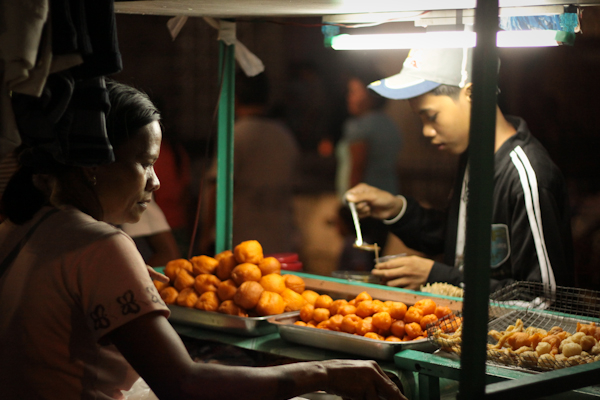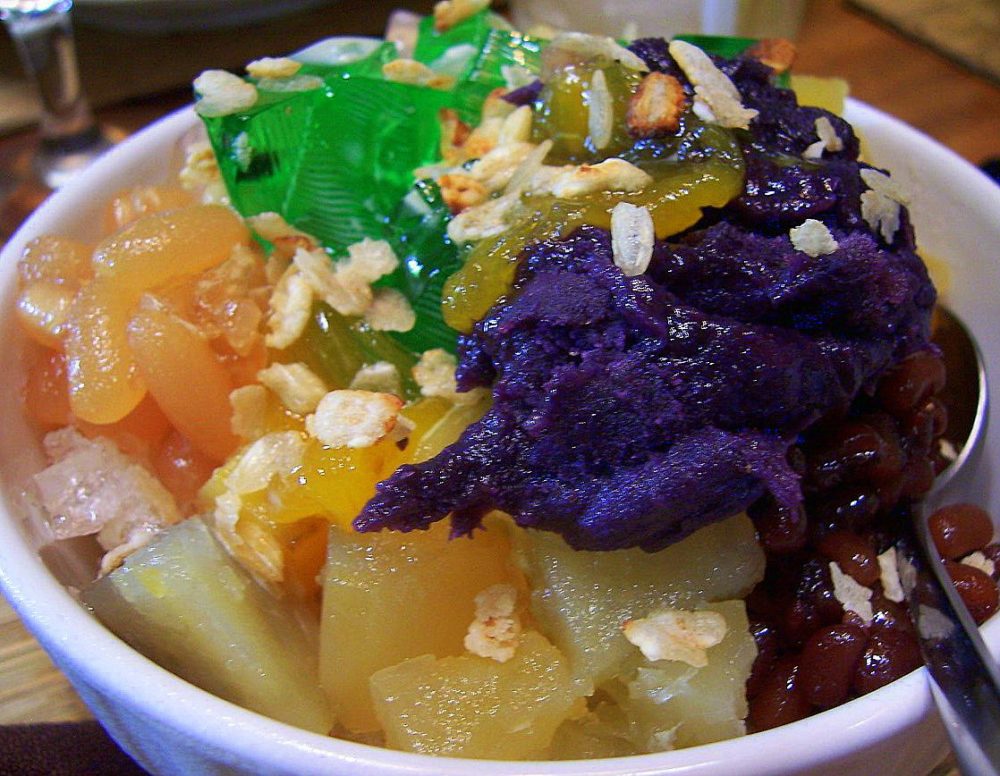The Philippines struggles to rival other Asian countries in terms of international renown for its cuisine. This seems unfair, as the archipelago boasts one of the most unique and fun cuisines in the world. Here are some of the more unusual foods that can be tasted in the Philippines.

A kwek kwek stall at night (Photo: Brian Dys Sahagun via Flickr)
China, South Korea, Japan and Thailand are all considered eminent international cuisines. You can find restaurants selling variants of popular food from any one of these countries in practically any western city. Moreover, these restaurants are not just popular with their own diasporas, but attract customers from all over.
So it seems almost criminal that another culinary superstar of the East/Southeast Asian region seems to go overlooked. Philippine cuisine is an absolute revelation. With delicacies coming from around 2,000 inhabited islands, each offering its own take on local produce, this is one of the most playful, inventive and unusual cuisines in the world, with remarkable diversity and a whole range of regional, Chinese and colonial influences creeping in. Filipinos are food-obsessed: it’s ingrained in the strong culture of hospitality (a common greeting is to ask if your guest has already eaten – ‘Kumain ka na ba?’). Also, they fry a lot of things. So it might not win any awards for healthiest cuisine, but who wants that boring old accolade anyway?
If you’re not into meat, Filipino food might be a challenge, which might seem strange in a part of the world so rich in exotic fruits and greens. The phrases you need to know in Tagalog are ‘gulay’ – vegetarian – and ‘walang karne’ – no meat – but be warned: most locals consider chicken to be a vegetarian staple. Depending on the region, look for dishes like ‘lanka’ – jackfruit, often cooked in coconut milk and tasting surprisingly like chicken, or pako (fern salad).
In the Philippines, the flavor combinations are bold, tangy, even pungent – you are likely to find your fish stuffed with pork, and your fresh mangoes drenched in bagoong fish sauce. There are a couple of dishes that could be said to define the country’s cuisine, such as lechon – and entire pig spit roast – or adobo – grilled chunks of meat marinated in vinegar, spices and soy sauce – and these can be commonly found. But they’re not necessarily unique in that they cannot be found elsewhere in one form or another. This list explores the types of dishes that are unlikely to be encountered in such a form elsewhere in the world. One authentic culinary experience is the ‘boodle fight’, eating with your hands (kamayan style) from a table length stretch of banana leaves. If you’re feeling adventurous, order whatever’s available from the busy food stands you can find in any village or on any island. Whether you find it delectable or a bit iffy, be sure to tell the vendor that it’s masarap – delicious!
Balut

Balut is not for the faint-hearted (Photo: Jerick Parrone via Flickr)
Balut could well be onomatopoeic for the involuntary sound somebody makes when first confronted with balut and forced to eat it. The most notorious Filipino snack, balut are chicken or most commonly duck eggs that are allowed to incubate for around two weeks, so that the egg has incubated right up to the point that a bird is almost formed, ready to hatch. That is often enough to put most people off, however when you get past the thought (and sight) of it, you have a nice cross in taste between duck meat and a boiled egg. Of course there is vinegar and salt on hand to season and take some of the edge off too. Balut is the go-to late-night snack for Filipinos on a pub crawl, and locals are particularly gleeful about convincing foreigners to try it, when the delicacy becomes pure entertainment.
Pancit

Pancit Palabok looking pretty delicious (Photo: Dennis Amith via Flickr)
There are plenty of different things vying for title of national dish in the Philippines, but pancit might well be one of the foremost contenders. Similar to Singapore noodles, it is a fairly simple dish with good helpings of vegetables and meat. There are different pancit variatons, including pancit bihon, which is commonly with chicken.
The more versatile pancit palabok is a surf and turf free-for-all, with shrimp and ground pork mixed together. Usually into this is added the occasional oyster, bit of squid and chopped up boiled egg. It really does manage to cover all the bases in one dish. Finally, pancit canton, the name suggesting probably a Chinese influence, is similar to the palabok but includes sausage.
Kamaro

Fried crickets anyone? (Photo: K Loh via Flickr)
This has nothing to do with sensible eating and everything to do with crickets. Specifically field, or mole, crickets, which are stubby little hoppy things until they are thrown into a pot and boiled with vinegar and garlic, but not before removing their legs and wings, which mainly just get stuck in your teeth and aren’t very fun to eat at all.
Kamaro are at best a snack, some would say an appetiser but that might be taking it a bit too far. They are also a seasonal food and so may be tricky to find during most of the year. They are most popular, and easily sourced, in the Pampanga region, the Filipino food capital located a few hours north from Manila.
Sisig

Sizzling sisig with an egg on top (Photo: Erik Teng Photography via Flickr)
Certainly not the most alluring of dishes on paper, sisig is surprisingly tasty and extremely popular in the Philippines. It takes the parts of the pig you’d be happier to grind up and feed to your dog: liver, cheeks and other head parts, then grills it all up together and mixed it with onions, a little chili, kalamansi (tiny green citrus fruit used to season most dishes) and topped off with a fried egg.
Before that, depending on the part of the pig’s head used, the meat is boiled and the hairs have to be removed. Nobody wants hairy pig meat. Sisig is best served on a metal hotplate, which keeps it sizzling, with a freshly cracked egg on top, although the street food variety will likely be served on a paper plate. Don’t be surprised to find it on a breakfast menu. (Vegetarians, do not despair: some of the more evolved restaurants may offer a tofu-based sisig substition.)
Kwek Kwek

A kwek kwek stall at night (Photo: Brian Dys Sahagun via Flickr)
It might be the noise that quail make, or it could just be tagalog, but the kwek kwek are delicious quail or chicken eggs fried in a fluffy orange batter. When done best, this popular Filipino street food snack is nice and crunchy on the inside.
But don’t eat them on their own; the best way to enjoy kwek kwek is to drown them in a vinegar sauce, which you will almost always find in a tub with a ladle at the kwek kwek stall. Then pop a little of chili sauce on top and you’re good to go. The quail eggs are usually bite-sized and sold on a skewer, while the chicken egg kwek kwek are pretty hefty and are often sold on their own.
Betute

Frogs that have sadly seen better days (Photo: Paul Stafford)
Definitely receiving full marks for originality, cuisine in the Philippines certainly does not shy away from mixing their meats. This might stem from the fact that loads of dishes are made with fish oil, which is ridiculously delicious, and has therefore broken the taboo. In the case of betute, you take some delicious ground meat like pork or beef. Nothing unusual about that, right? Then you go and stuff it into a frog. Whoa! That got weird pretty fast.
Betute is not so widespread in the Philippines and you’d probably have to track it down at a special restaurant in most parts of the country, but this is considered quite a delicacy in the Philippines. Once the frog is stuffed, along with some garlic and vinegar, it is then deep fried until crispy.
Kare Kare

Seafood kare kare is a variation of the classic (Photo: louis r via Flickr)
When some genius came up with the idea of blending peanut butter with chocolate, the world thanked them, and continues to do so. Well the lesser known, but equally delightful peanut butter pairing, that you may never have contemplated before, is oxtail stew.
Kare kare has a nice ring to it. The peanuts are crushed and combined with toasted rice into a paste. Usually string beans and aubergine are tossed into the mix along with the meat, making a very pleasing and moreish dish. There are some variations of kare kare too, such as seafood (served with prawns, squid and oysters) or vegetarian (with eggplant). Basically peanuts will go well with anything and kare kare proves it.
Sinigang

Sinigang soup with shrimp, fish and eggplant (Photo: Allan Reyes via Flickr)
One of those dishes all Filipino grandmothers know how to make, sinigang is a hot and sour soup made with a sampalok (tamarind) base, which has a bitter-sweet taste, and tart kalamansi limes. Add to that the delicious milk of a coconut and some chunks of pork, then top it off with some shredded chilies and serve over a bed of steamed rice.
Sinigang can also be served with beef, prawns or fish and vegetables, like taro or chayote. It’s quite a strong tasting, but light, soup all at the same time. It is one of those dishes that is revitalising and refreshing and perfect for any Southeast Asian climate.
Isaw

Isaw chicken intestines on a skewer (Photo: RodelBontes via Flickr)
Chicken intestine comes in two styles in the Philippines, which is great because you struggle to find chicken intestine in even one style pretty much anywhere else. Have your chicken intestine fried or grilled and served on a kabab stick. This is generally available from street food stalls. Not surprisingly the fried version is covered in batter and chewy on the inside, not unlike calamari in texture.
The grilled version is cooked adobo (grilled) style and is much chewier than its fried brother. Most people would agree that the taste is far better than the expectation, and is similar to any kind of grilled chicken.
Halo Halo
This list would be a disappointment if at least one of the many delicious deserts of the Philippines didn’t make the cut. ‘Halo halo’ is Tagalog for mix-mix, and that’s exactly what you get when you order this mash-up of evaporated milk, crushed ice, ube (purple yam) jam or ice cream, cubed agar jellies, jackfruit, sweet corn, sago, red bean, or whatever else they can think of cramming in there to make it look like a flamboyant dog’s breakfast. A fun, messy and colorful treat… If you can fit anything else in after your main meal.
Co-Author: Mélissa Lesnie
